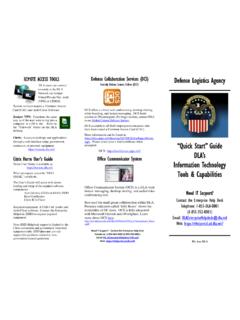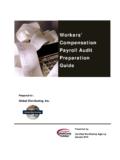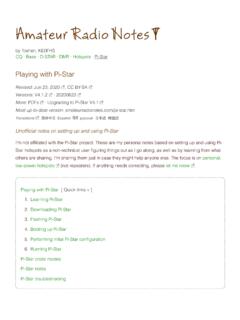Transcription of JOURNAL OF LA How to Use the IEEEtran LATEX Class
1 JOURNAL OF LATEX Class FILES, VOL. 1, NO. 11, NOVEMBER 20021 how to Use the IEEE tran LATEX ClassMichael Shell,Member, IEEE(Invited Paper)Abstract This article describes how to use the IEEE tranclass with LATEX to produce high quality typeset papers thatare suitable for submission to the Institute of Electrical andElectronics Engineers (IEEE). IEEE tran can produce conference, JOURNAL and technical note (correspondence) papers with asuitable choice of Class options. This document was producedusing IEEE tran in JOURNAL mode.
2 Conference and correspondencepapers typically use a subset of the commands discussed Terms Class , IEEE tran, LATEX , paper, style, template, INTRODUCTIONWITH a recent IEEE tran Class file, a computer run-ning LATEX , and a basic understanding of the LATEX language, an author can produce professional quality typesetresearch papers very quickly, inexpensively, and with minimaleffort. The purpose of this article is to serve as a user guideof IEEE tran LATEX Class and to document its unique featuresand document applies to version and later of versions do not have all of the features described will display the version number on the user s consolewhen a document using it is being compiled.
3 The latest versionof IEEE tran and its support files can be obtained from IEEE sweb site [2], or CTAN [1]. This latter site may have someadditional material, such as beta test versions and files relatedto non-IEEE uses of to this document are the are bare bones example(template) files of a conference and a JOURNAL paper, respec-tively. Authors can quickly obtain a functional document byusing these files as starters for their own is assumed that the reader has at least a basic workingknowledge of LATEX . Those so lacking are strongly encouragedto read some of the excellent literature on the subject [3].
4 Gen-eral support for LATEX related questions can be obtained in theinternet newsgroup There is also a searchablelist of frequently asked questions for this newsgroup [4].Please note that the appendices sections contain informationon installing the IEEE tran Class file as well as tips on how toavoid commonly made created February 25, 2002; revised November 18, 2002. Thiswork was supported by the IEEE. The opinions expressed here are entirelythat of the author. No warranty is expressed or implied. User assumes all Shell is with the Georgia Institute of : See [1] for current contact that it is the convention of this document not to hyphenate command,file or in-main-text URL names and to display them intypewriter such constructs, spaces are not implied at a line break and will beexplicitly carried into the beginning of the next line.
5 This behavior is nota feature of IEEE tran, but is used here to illustrate computer CLASSOPTIONST here are a number of Class options that can be used tocontrol the overall mode and behavior of IEEE tran. These arespecified in the traditional LATEX way. For example,\documentclass[9pt,technote]{IEE E tran}is used with correspondence (technote) papers. The variouscategories of options will now be discussed. For each category,the default option is shown in bold. The user must specify anoption from each category in which the default is not the onedesired.
6 The various categories are totally orthogonal to eachother changes in one will not affect the defaults in 9pt,10pt, 11pt, 12ptThere are four possible values for the normal text size. 10ptis used by the vast majority of papers. The two exceptions aretechnote papers, which use 9pt text, and the initial submissionsto some conferences which use draft, draftcls, draftclsnofoot,finalIEEE tran provides for three draft modes as well as thenormal final mode. The draft modes provide a larger linespacing to allow for editing comments. The standard draftoption putseverypackage used in the document into draftmode.
7 With most graphics packages, this has the effect ofdisabling the rendering of figures. If this is not desired, onecan use the draftcls option instead to yield a draft mode thatwill be confined within the IEEE tran Class so that figures willbe included as normal. draftclsnofoot is like draftcls, but doesnot display the word DRAFT along with the date at the footof each page. When using one of the draft modes, most userswill also want to select the onecolumn conference, JOURNAL , technote, peerreview, peerreviewcaIEEE tran offers five major modes to encompass conference, JOURNAL , correspondence (technote) and peer review and technote modes will produce papers very similarto those that appear in manyIEEE using technote, most users should also select the 9ptoption.
8 The peerreview mode is much like the JOURNAL mode,but produces a single-column cover page (with the title, authornames and abstract) to facilitate anonymous peer review. Thetitle is repeated (without the author names or abstract) on thefirst page after the cover using the peer review2A blank page may be inserted after the cover page when using the twoside(duplex printing) option so that the beginning of the paper does not appearon the back side of the cover 0000/00$ 2002 IEEE2 JOURNAL OF LATEX Class FILES, VOL. 1, NO. 11, NOVEMBER 2002options require an\IEEE peerreviewmaketitlecommand(in addition to and after the traditional\maketitle) to beexecuted at the place the cover page is to end usuallyjust after the abstract.
9 This command will be silently ignoredwith the non-peerreview modes. See the bare template filesfor an example of the placement of this command. Thepeerreviewca mode is like peerreview, but allows the authorname information to be entered and formatted as is donein conference mode (see Section for details) so thatauthor affiliation and contact information is more visible tothe ) Conference mode details:Conference mode makes anumber of significant changes to the way IEEE tran behaves. The figure captions are centered. The\authortext is placed within a tabular environmentto allow for multicolumn formatting of author names andaffiliations.
10 Several commands are enabled to facilitatethis formatting (see Section for details). The spacing after the authors names is reduced. So isthe spacing around the section names. The special paper notice (if used) will appearbetweentheauthor names and the title (not after as with journals). The margins are increased as the height of the text isreduced to about In particular, the bottom marginwill become larger than that of the top as IEEE wantsextra clearance at the bottom. The text height will not beexactly , but will vary slightly with the normal fontsize to ensure an integer number of lines in a column.







